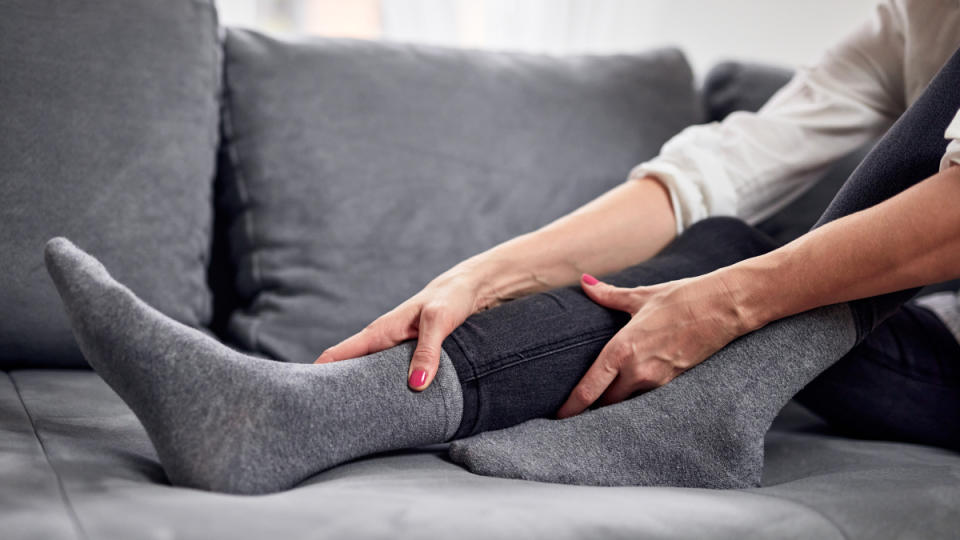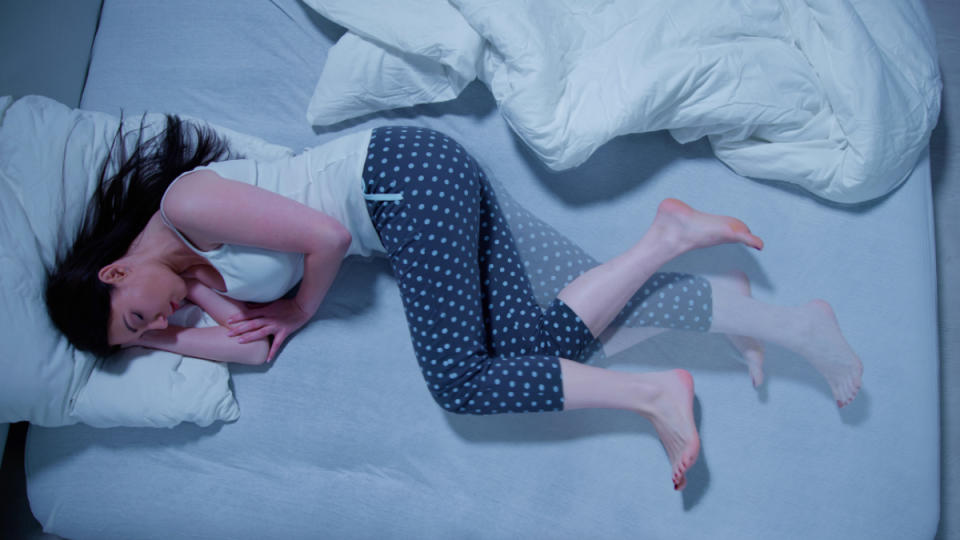This Relaxing Type of Physical Exercise Can Ease Restless Leg Syndrome + Improve Sleep
Do you ever jump out of bed some nights, eager to stop that creepy, crawling feeling in your legs? If you have restless leg syndrome, physical exercise can help relieve the intense urge to move. The key: Homing in on the most beneficial types of exercise and practicing them regularly. Here, experts reveal the best moves to find relief, plus more natural ways to quiet that "gotta move" urge.
What is restless leg syndrome?
“Restless leg syndrome, or RLS, is a condition in which people have abnormal sensations in their legs," says neurologist Andy Berkowski, MD, founder of ReLACS Health, a clinic dedicated to the treatment of complex sleep disorders like RLS. “The hallmark symptom is the urge to move, and movement relieves the urge."
Another telling symptom of RLS (also known as Willis-Ekbom disease): It occurs when you're at rest or during periods of inactivity, adds physical therapist Catherine Siengsukon, PhD, director of the Sleep, Health & Wellness Laboratory at the University of Kansas Medical Center. The sensation in the legs, described by some as itching, tingling, throbbing or creeping, makes moving the legs simply irresistible.

Related: “A Drugstore Cure Calmed My Restless Legs Immediately — I Can Finally Sleep!”
Common causes of restless leg syndrome
The exact mechanism behind RLS isn’t known, but it appears to be related to nutrient deficiency or chemical imbalances in the brain rather than the muscles in the legs, says Siengsukon. A thorough medical workup can help pinpoint what’s behind your RLS, and there may be multiple contributing factors. These include:
Lack of physical activity
Iron deficiency or iron-deficiency anemia
A disease that causes inflammation, such as diabetes or ulcerative colitis (Click through to see how trendy pu-erh tea can ward off diabetes)
A genetic predisposition (RLS seems to run in families)
Taking certain medications such as antihistamines, antidepressants, anti-nausea drugs or antipsychotics
Often, low levels of iron are to blame. Anemia is caused by insufficient iron in your diet or too little iron due to blood loss (such as heavy menstrual bleeding). When your body doesn’t have enough iron to produce hemoglobin, the substance in red blood cells that enables them to carry oxygen throughout your body, you experience fatigue and other symptoms. (Click through to learn more about iron deficiency without anemia — plus the best way to cure it.)
If you have RLS symptoms, be sure your doctor checks your iron levels and scrutinizes the lab results, says Dr. Berkowski. People with RLS need much higher iron levels than those suggested by the lab report’s “reference ranges.” Iron levels that appear normal may be too low for people with RLS, Dr. Berkowski notes.
For those with a deficiency, the problem can be addressed in a straightforward way. If your iron levels are in a healthy range, physical exercise and other natural remedies can help ease restless leg syndrome symptoms.
How restless leg syndrome affects sleep
With RLS, the urge to move your legs so overwhelmingly powerful that you cannot ignore it and sleep. The intense desire to move is part of the reason the condition is considered both a sleep disorder and a neurological disorder. RLS urges force you to stay awake and disrupt deep sleep, which often leads to insomnia or depression.
Up to 10% of the population experiences RLS, according to estimates in Sleep Medicine. More common in women, RLS risk increases with age. And since restless syndrome is a life-long condition, it can be managed but not cured.
In most people, symptoms occur anywhere from once a month to once a week. While it's bothersome, it can often be relieved by stretching or going for a little walk, says Dr. Berkowski, who serves on the American Academy of Sleep Medicine (AASM) clinical guidelines task force. But if RLS symptoms become very uncomfortable or disrupt your ability to sleep, it's time to seek medical attention, he adds.

Related: Tossing and Turning at Night? Ashwagandha Is an Ancient Herb That Deepens Sleep Naturally
Physical exercise calms restless leg syndrome
Experts agree: physical exercise helps reduce restless leg syndrome symptoms in many ways. Siengsukon recommends moderate aerobic exercise like walking, cycling, swimming — “anything that makes you feel tired and sleepy,” she says. The ideal dose is moderate exercise every day.
Sitting all day is the worst, adds Dr. Berkowski, who suggests that people who are not active start out walking for 20 minutes three times a week. Then, gradually add more time until you build up to 30 minutes five times a week.
While regular movement may address multiple underlying issues or provide feedback to the brain, there is no one specific move or “magic stretches” that will cure RLS, Siengsukon notes. Still, studies have shown certain types of physical exercise to help when it comes to calming restless leg syndrome. (Need a lighthearted laugh to help you get motivated? Check out our funniest exercise memes.)

The best physical exercise for restless leg syndrome
In addition to doing some cardio early in the day, Siengsukon recommends relaxing physical exercise such as yoga in the late afternoon or evening for restless leg syndrome.
“In general, mild-moderate stretching and moderate exercise have been most closely associated with relief," says neurologist Charlene Gamaldo, MD, assistant professor at the John Hopkins School of Medicine and Fellow of the American Academy of Neurology. "Yoga can be a nice place to start."
Siengsukon agrees, adding that while yoga has been shown to have some effect, it probably comes from a different mechanism than cardiovascular exercise. “It likely has a calming effect on our 'fight or flight system',” she says, referring to yoga’s proven ability to help people shift from stress mode to relaxation mode.
In fact, a small study in the Journal of Alternative and Complementary Medicine looked at the impact of an 8-week Iyenar yoga program (which focuses on body alignment) on women with moderate to severe RLS. It consisted of two 90 minute classes and 30 minutes of home practice on non-class days. Researchers found that the basic, but frequent, gentle yoga practice reduced RLS symptoms and improved sleep and mood.
Not sure where to get started? Check out the video below that focuses on gentle Iyengar poses, including many of the same ones used by study participants.
More natural remedies for restless leg syndrome
In addition to physical exercise for restless leg syndrome, these other expert-backed remedies can help ease symptoms.
1. Up your iron intake
It typically isn't a challenge to get enough iron through your diet if you eat meat, says Debbie Petitpain, MS, RDN, a dietitian who experiences RLS and is a patient advocate. “Consuming iron-rich foods such as red meat, poultry, fish and fortified cereals can help. That's especially true if you pair iron-rich foods with vitamin C sources, like citrus fruits, to enhance iron absorption." Plant sources of iron, which are less easily absorbed, include beans and leafy greens.
If you've increased your intake of iron-rich foods and your levels are still low, your doctor may recommend supplements, says Petitpain. “Ask about iron infusion treatments, too,” she suggests. Infusions that put iron directly into the blood via IV may work even faster than supplements.
“Iron infusion is a powerful, safe and effective tool to relieve restless legs by getting the iron levels up," Dr. Berkowski adds. "That's something a doctor could order for someone who can't get their iron levels up naturally."

2. Cut back on caffeine
Whenever possible, avoid RLS triggers such as caffeine, nicotine and alcohol. Petitpan recommends switching to "half-caff" coffee (a 50-50 blend of caffeinated and decaf coffee) to start cutting back on caffeine slowly. Can't go completely caffeine-free? Avoiding caffeine 12 hours before bedtime can help, too.
Related: Does Chocolate Have Caffeine? Yes — And Higher-End Dark Chocolates Have The Most
3. Relax in a warm bath
A warm, soothing soak before bed is helpful for Petitpain's RLS symptoms. The mechanism behind it isn't yet fully understood, but experts suspect the warmth can help distract your mind and counter gotta-move sensations in the legs.
Tip: If a hot bath doesn't do the trick, consider soaking your legs in cool water instead. One study in Complementary Therapies in Medicine found that women who immersed their legs in cold water for 10 minutes every evening for two weeks noticeably reduced RLS symptoms. (Click through to learn how cold water tones your vagus nerve to ease the effects of chronic stress, too.)

Other tips that may work
Distracting yourself during downtime in the evening with an engaging activity such as reading, knitting or other crafts really helps, says Siengsukon.
Assess your current medications. Antihistamines and some antidepressants can worsen RLS symptoms. Don’t stop or change your medications without consulting your doctor, who can help you switch or adjust them in a safe way.
Ask to be evaluated for other sleep disorders. Some people with RLS also have obstructive sleep apnea.
Working with a physical therapist (who can create a personalized exercise plan) helps some people find effective physical exercises for easing their RLS symptoms.
Hydration is crucial, especially if you start a new exercise routine. Just don’t drink liquids within 4 hours of bedtime, warns Petitpain.
Practice good sleep hygiene, waking and going to bed at the same time every day.
Eat a healthy, balanced diet with a variety of fruits and vegetables.
What you need to know before taking RLS meds
Treatment recommendations for RLS are changing. Yet according to Dr. Berkowski of the 2024 ASSM recommendations task force, it may be many years before all primary care doctors are up to speed. Some medications known as dopamine agonists that were previously strongly recommended for RLS treatment have actually been shown to worsen RLS, Dr. Berkowski says, and will no longer be recommended.
The takeaway: Physical exercise — and the other natural remedies above — are great tools to help reduce restless leg syndrome symptoms naturally. Don’t start or stop taking dopamine agonists without discussing with your doctor the possible side effects and complications. And make sure your doctor tests your iron levels before prescribing medication (iron infusions will be added to future treatment guidelines). Medications that will continue to be recommended for RLS include anticonvulsants such as pregabalin, gabapentin and gabapentin enacarbil.
For more ways to outsmart common sleep bothers and snooze soundly:
Too ‘Wired and Tired’ To Fall Asleep? MDs Explain Why It Happens — And the Easy Fixes
Tossing and Turning at Night? Ashwagandha Is an Ancient Herb That Deepens Sleep Naturally
This content is not a substitute for professional medical advice or diagnosis. Always consult your physician before pursuing any treatment plan.
